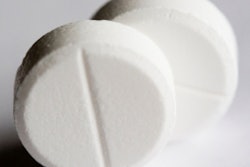
Teeth whitening is one of the most popular dental procedures today, but it often comes with the undesirable side effect of tooth sensitivity.
Now a new study has found that a calcium-containing 35% hydrogen peroxide gel can reduce tooth sensitivity during in-office dental bleaching (Journal of the American Dental Association, December 2012, Vol. 143:12, pp. e81-e87).
Manufacturers have attempted to reduce bleaching-related sensitivity by adding desensitizing agents such as fluorides and potassium nitrate to the formulation of bleaching gels, but the benefits of including these agents remain unclear, the study authors noted.
Some studies have shown the effects of calcium-containing compounds in bleaching gels with the aim of preventing the mineral loss and reduction in enamel microhardness produced by bleaching, they added. If these components do indeed prevent mineral loss, it is possible that hydrogen peroxide penetration may occur at a lower diffusion rate, reducing sensitivity.
"To our knowledge, no clinical study investigators have evaluated the clinical benefits of such inclusion," wrote the study authors, which prompted them to conduct a randomized clinical trial to assess the whitening efficacy and sensitivity associated with a 35% hydrogen peroxide gel containing 2% calcium gluconate.
Stable pH key
The researchers recruited 40 study participants from the State University of Ponta Grossa School of Dentistry in Brazil. Participants were at least 18 years old and had good general and oral health. The study took place in the dental school's clinic from March 2009 through April 2010.
They randomly divided the participants into two groups, in which one received bleaching with the calcium-containing gel and the other received bleaching with a calcium-free gel.
The researchers performed two bleaching sessions with a one-week interval in between. They registered the color at baseline and after the first and second bleaching sessions by using a shade guide. They also gauged the participant's perception of tooth sensitivity as registered on a scale from 0 (none) to 4 (severe).
They found that both groups had similar and significant teeth color enhancement with an average bleaching of seven to eight shade-guide units. Most of the participants from the calcium-free group (80%) experienced sensitivity, while 40% of participants from the calcium-containing group reported experiencing sensitivity. The intensity of sensitivity was significantly higher for the calcium-free group during in-office dental bleaching.
"It is likely that the addition of calcium gluconate and the stable and high pH of the calcium-containing product were responsible for the reduced sensitivity reported by participants receiving this bleaching agent in our study," the authors concluded. "The calcium-containing hydrogen peroxide gel caused less sensitivity during in-office dental bleaching without any deleterious effects on bleaching effectiveness."
Related research
This is not the first time that calcium gluconate has been tested as an addition to bleaching gels. A study presented last year at the International Association for Dental Research meeting tested whether the addition of 2% calcium gluconate to bleaching gels reduces whitening efficacy.
The authors of that study reported that the addition of calcium in the bleaching gels does not interfere with the whitening effect. These results can be considered favorable for the clinical performance of bleaching agents since the advantageous effects of adding remineralizing agents to reduce the possible adverse effects to enamel did not impair the bleaching result of gels tested, they noted.
The efficacy of calcium compounds in relieving bleaching-related sensitivity also has been tested, and not just as an addition to gels. One study looked at whether chewing sugar-free gum containing Recaldent (casein phosphopeptide-amorphous calcium phosphate [CPP-ACP]) could reduce the incidence, duration, and intensity of whitening-induced tooth sensitivity.
The authors of that study looked at 88 patients who had their teeth whitened in a single in-office visit, and following the procedure, each patient was randomly assigned to one of three study groups, in which one used a sugar-free chewing gum with Recaldent, one group did not use any desensitizing agent, and the third used a sugar-free chewing gum without Recaldent.
The participants returned for a 24-hour follow-up visit where they completed a questionnaire regarding tooth sensitivity.
"This study suggested that using a sugar-free chewing gum (both with and without CPP-ACP) could reduce the intensity of tooth sensitivity associated with in-office whitening procedures," the authors concluded. "However, it failed to demonstrate conclusively that using a sugar-free chewing gum with CPP-ACP could provide additional therapeutic benefits.



















